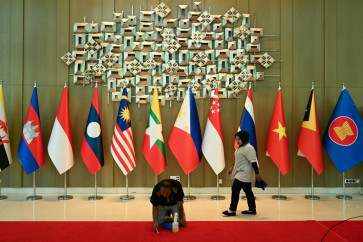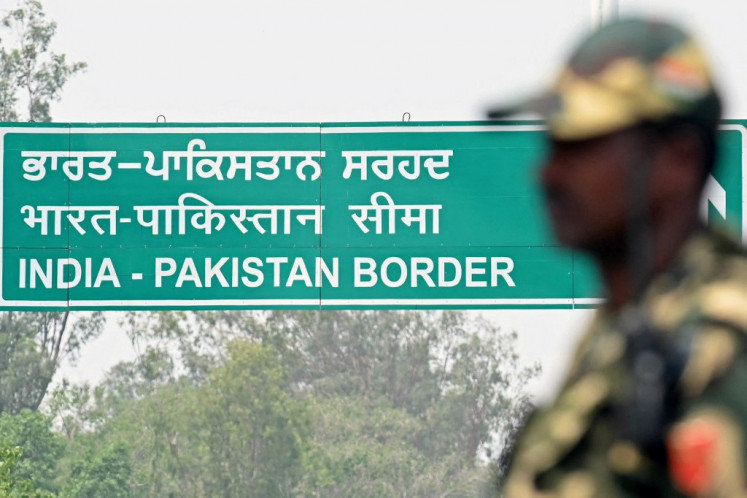Cities in darkness: Searching for new hope
Ask any politician at the House of Representatives in Senayan who the real victims of rampant annual land and forest fires in Sumatra are
Change text size
Gift Premium Articles
to Anyone

A
sk any politician at the House of Representatives in Senayan who the real victims of rampant annual land and forest fires in Sumatra are. They will most likely say that the main victims of the catastrophic haze in 1997/1998 and 2015 have been Singaporeans and Malaysians. Why do powerful people in Jakarta still think like this?
And why does the Presidential Palace seem to react to complaints from Singapore and Malaysia while forgetting the voices from Palangkaraya and Riau?
The total population of Sumatra and Kalimantan is about 70 million. About 60 percent (42 million) have been affected by the haze catastrophe this year. And if not managed properly, the impact could reach 70 million people in total in Indonesia, Malaysia and Singapore, just as in 1997/1998.
Most victims are clearly powerless Indonesians. And since the real losses and human cost are never counted, the people in power are busier reacting defensively to demands from abroad than listening to their own people ' while more than 110,000 across South Kalimantan, Pekanbaru, South Sumatra, West Kalimantan and Central Kalimantan suffer from acute upper respiratory tract infections.
Reports have said Palangkaraya in Central Kalimantan has become darker, with vision down to 50 meters. One morning the Pollutant Standards Index (used by Singapore) reached 2,314 ' 660 percent higher than the hazardous tolerance limit of 350.
The World Health Organization revealed that with an annual exposure to a concentration of particulate matter (e.g. haze) at SPI 350, one's life could be shortened by 15 percent.
Indonesians are indeed the real losers, and the prevalence of long-term health risks including lung impairment and cancer will increase.
One Facebook page made by locals of Bengkulu on Sumatra's south west coast is cynically titled 'Haze Runner: The Sore Throat Trials'. The effort to fight the haze is clearly more challenging to them than whatever the movie Maze Runner: The Scorch Trials can offer.
If you were a freshman in Riau, this year would be special because you would have spent the whole 18 years of your life regularly exposed to haze. You might be curious about what it would be like to live a whole year without haze.
As a result, you may express similar sentiments on Facebook as that of my colleagues. 'Bored with the haze! Enough!' and 'We are tired,' being just two examples.
These complaints are not from Malaysians or Singaporeans. They are being posted from Kalimantan and Sumatra, even from Banda Aceh, in our westernmost region. I was pleasantly surprised when the former president Susilo Bambang Yudhoyono finally ratified ASEAN's Transboundary Haze Agreement in 2014 after it was passed in 2002.
Can President Joko' Jokowi' Widodo make a difference? Maybe yes, maybe no.
The impact of any ratification of international treaties and conventions is never immediately seen and felt on the ground. The devil is always in the details: detailed assessment of potential risk, detailed assessment of national and local capacity ' one needs more clarity in terms of human resources, financial resources, technology, scale of risks and capacity to respond.
My disaster risk governance research suggests that national adoption of an international disaster reduction framework often involves more than five to 10 years of preparing local policy adjustments. Detailed implementation of risk reduction often takes longer.
Therefore, we hope the government will welcome help from our neighbors. Meanwhile, there are at least four key challenges to be overcome by governments at the national and local level regarding the haze and other nature-related problems.
First is the 'proximity theory' aspect of the crisis ' disasters are often located far away from Jakarta and Java. Apart from the Indian Ocean tsunami, most large-scale disasters that have occurred away from these centers of power have had insufficient responses.
The case of the Sinabung volcano eruption in North Sumatra provides an example. At that time then president Yudhoyono responded rapidly to crises in Java, but often very slowly addressed disasters outside Java. This needs to change.
A second challenge is 'governance deficit', which often causes an asymmetric response from central and local governments. In his first year in power Jokowi has shown how promptly he can respond to crises.
Yet his visits to the problem hotspots do not necessarily translate into a significantly policy response implementation.
They should be read as an early endeavor to comprehend the scale and severity of a crisis as well as an attempt to look for early ideas for the solutions to long-term problems.
However, the ineffective bureaucracy in regencies and provinces often do not anticipate the onset of the haze.
Third, the absence of a unified command system makes haze crisis management ineffective. It doesn't really matter how many times Jokowi flies to hot spots. What matters most is whether there is an adequate response to the disaster. If this continues to occur in Sumatra and Kalimantan, can Jokowi declare not only a national disaster, but also a clear command system for the haze crisis response?
Such an approach will allow not only proper allocation from the national budget and structure, but also welcome the international community to help. The approach would also end the disconcerting, conflicting responses from the President and Vice President regarding the need for external aid to end the fires.
Fourth, haze risk ignorance. El-Niño has been predicted to arrive in the region since 2013/2014.
Thousands of hotspots were also detected in Papua, where hundreds of flights were canceled. El-Niño in itself may cause natural fires. But in an already vulnerable ecosystem, small triggers can rapidly escalate an ecological catastrophe. Without strong controlled burning measures, the increased risk is hard to measure.
The recent demonstrations of university students in Pekanbaru, Riau, included the following demands. First, the government must declare a disaster emergency as the haze has caused widespread health problems. Second, the government must continue to take legal action against businesses responsible for starting any fires.
This demand has been responded to well by Jokowi. Third, free health treatment for those with acute respiratory infections given the failures of the government to avoid the disaster ' another demand that has also been answered. Last, evacuate people in Riau to safer areas. But to where could they go?
Unfortunately, there is still a lack of collective action from civil society as well as from haze victims. Civil society groups must create sustained pressure at the local and national level demanding accountability in haze management.
Policy makers must wake up.
Solving the fires and haze is not merely about helping Malaysia and Singapore. It is about fulfilling the rights of citizens in affected regions while protecting the environment.
___________________________________
The writer is a research fellow at the Centre for Non-Traditional Security Studies at S. Rajaratnam School of International Studies, Nanyang Technological University in Singapore.









